Abstract
This study presents a sustainable and adaptive approach to mineral processing. A hybrid intelligent control system was developed to beneficiate fine chromite ore in a jigging machine. The objective is to enhance separation efficiency and reduce chromium losses through real-time optimization of process parameters under variable feed conditions. The method addresses ore composition fluctuations by integrating three components: Physical modeling of particle motion, regression analysis, and neural network-based prediction. The jig bed level and pulsation frequency are used as control variables, while the Cr2O3 content in the feed () is treated as a disturbance. A neural network predicts the Cr2O3 content in the concentrate () and in the tailings (), representing chromite-rich and gangue fractions, respectively. The optimization is performed using a constrained Interior-Point algorithm. The model demonstrates high predictive accuracy, with a mean squared error (MSE) below 0.01. The proposed control algorithm reduces chromium losses in tailings from 7.5% to 5.5%, while improving concentrate quality by 3–6%. A real-time human–machine interface (HMI) was developed in SIMATIC WinCC for process visualization and control. The hybrid framework can be adapted to other mineral processing systems by adjusting the model structure and retraining the neural network on new ore datasets.
1. Introduction
The development of sustainable technologies is a pressing issue for the mining and metallurgical industry. Along with the traditional goals of increasing the efficiency of ore mining and processing, the need to minimize environmental impact and ensuring sustainable development of the industry are becoming increasingly important [1].
Mineral processing is a key link between the mining and metallurgical industries. This process is accompanied by significant volumes of waste generated during ore processing, which is a serious problem [2]. As a result of the primary processing of minerals, significant masses of beneficiation tailings, sludge, and dust emissions are formed, containing residual metals, chemical reagents, and other harmful compounds [3]. According to research, depending on the type of ore and processing technology, the proportion of waste can reach 60–80% of the feedstock volume of raw materials, which creates not only an environmental burden, but also economic losses due to the disposal of potentially valuable components [4].
Mining and metallurgical waste represents one of the most significant problems in the industry, as it contains significant amounts of valuable metals such as chromium, iron, and nickel [5]. In addition to metal losses, large volumes of waste require large storage areas, which creates an additional burden on the environment. Tailings ponds occupy vast territories, and their operation is associated with high risks of soil and water pollution [6].
In these conditions, when the requirements for environmental friendliness of the extraction and processing of minerals are growing, automation, digitalization and optimization of technological processes are a key area contributing to the development of sustainable technologies in mineral processing [7]. Traditional methods of beneficiation processes automation, such as flotation, gravity beneficiation, and magnetic separation, are currently being gradually supplemented or replaced by sustainable solutions [8]. Among such innovations are digital twins, advanced control systems, and process optimization algorithms [9,10,11].
Modern digital technologies make it possible to collect and analyze large amounts of data, which opens up new opportunities for optimal control of industrial processes [12]. However, mineral processing is characterized by high variability in parameters, nonlinearity and uncertainty, making it difficult to apply traditional optimization methods.
The use of artificial intelligence (AI) and machine learning (ML) algorithms allows taking into account complex relationships between process parameters, predicting product yields and adapting equipment operating modes to achieve sustainable development goals [13,14]. Among the most effective technologies are Gradient Boosting, Random Forest [15], Artificial Neural Networks (ANN) [16], Deep Learning (DL), and Convolutional Neural Networks (CNN) [17].
However, AI methods in mineral processing face difficulties in interpretation, imperfect sensors, and lack of standards [18]. There remain unresolved issues related to the processing of big data, the development of universal models, and their integration into existing production systems [19]. Solving these problems requires further research and an interdisciplinary approach that combines mineral processing, artificial intelligence, and automatic control technologies [20]. Neural networks can accurately predict results based on training on a large amount of data but cannot provide detailed information on physical interactions such as the forces acting on particles or the fluid dynamics during separation.
In contrast, mathematical models are based on physical laws and equations, which allows for a deep understanding of the internal processes. Models such as the discrete element method (DEM) [21] and computational fluid dynamics (CFD) [22] allow for detailed investigation of physical interactions such as particle trajectories, particle-fluid interactions, and the influence of various external factors [23]. They allow us to study and optimize processes at a more fundamental level, based on the physical model of the system. However, such approaches are insufficient for describing the processes of complex systems, where many factors interact with each other. The solution to the problem is the development of hybrid models based on intelligent algorithms and mathematical models that can complement each other, providing both high-level control and deep understanding of physical processes. The implementation of such systems can significantly improve the efficiency of beneficiation processes.
The present work addresses the process of gravity beneficiation of chromite ore [24]. Chromium is used in metallurgy to produce ferrochrome and stainless steel. The beneficiation of chromite ore, especially fine grades, is associated with a number of technological and economic challenges, including low recovery rates, high energy consumption, and complex process control [25]. Consequently, there is a need to improve the processing technologies of both extracted and man-made raw materials, which are renewable resources that do not require costs for extraction and primary processing [26]. In addition, in a number of cases, the content of valuable components in man-made waste exceeds their content in developed natural deposits [27].
Traditional gravity beneficiation is based on manual operator input or fixed settings, limiting its adaptability to ore variability (see Table 1) [28]. The hybrid system uses predictive and physics-based models to adjust parameters in real time, improving efficiency and reducing losses [29].

Table 1.
Traditional vs. hybrid control systems in gravity beneficiation.
The primary objective of this research is to build a sustainable system for optimizing the ore separation process in real time, capable of adapting to changes in the composition of raw materials and operating conditions. The proposed hybrid approach combines knowledge of the physics of the process with the capabilities of intelligent control, contributing to the development of digital and sustainable technologies in the field of mineral processing.
In this article, the following research questions are considered:
- How can a hybrid intelligent control system be developed for sustainable and real-time control of gravity separation processes in chromite ore beneficiation?
- What advantages do the integration of physical modeling, regression analysis, and neural networks provide in terms of predictive accuracy, adaptability to fluctuating ore compositions, and support for sustainable processing?
- How can control parameters be optimized in real time to minimize chromium losses in tailings, maximize concentrate quality, and contribute to overall process sustainability?
- How does the proposed hybrid control system perform in terms of prediction accuracy, optimization convergence, and robustness under real-time industrial conditions?
The structure of the paper is organized as follows: Section 2 describes the method of gravity beneficiation in a jigging machine. Section 3 presents a hybrid model that includes regression analysis, a physical model of particle motion, and a neural network. Section 4 is devoted to the implementation of the real-time optimization algorithm. Section 5 presents the simulation results, analysis of prediction accuracy, and assessment control efficiency. Section 6 provides conclusions and proposals for further development of sustainable technologies in mineral processing.
2. Materials and Methods of Process Control
The method of gravity beneficiation of minerals is based on the difference in the speed of movement of mineral particles in a pulsating separation medium and can be used to enrich ores with a size from 0.1 to 400 mm [24]. Currently, the jigging process is used in world practice for beneficiation of iron, chromium, tin, tungsten, gold-bearing, and other ores. In Kazakhstan, this method of gravity beneficiation has found wide application in beneficiation plants of chromite ores.
Industrial units that implement the jigging process are jigging machines, which have a wide range of designs [23]. The modern industry of beneficiation devices has about a hundred designs of jigging machines, which vary by pulsation method and separation medium. This study investigates a jigging machine for gravity concentration of fine grade chromite ore in an aqueous environment by separating minerals primarily by density (see Figure 1). This device is used for beneficiation of fine-grade chromite ore with varying Cr2O3 content. The principle of operation is based on the separation of a mixture of concentrate particles and waste rock by density under the influence of a pulsating flow of water or air.
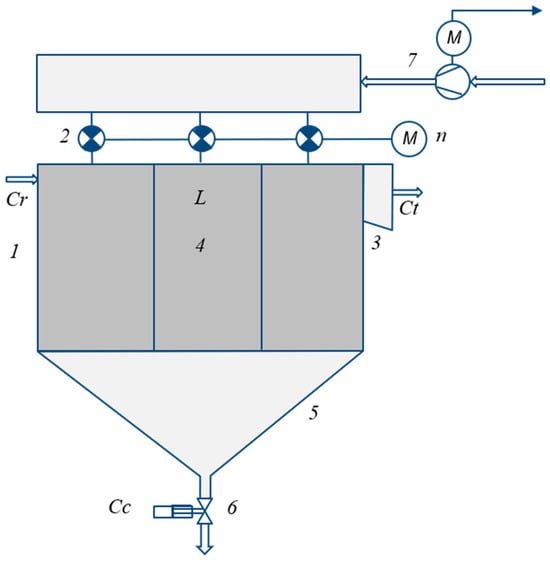
Figure 1.
Jigging machine.
The jigging machine uses hydraulic jigging, i.e., water is continuously fed into it, passing through the ore layer (bed). The feedstock with a chromium content of is fed via a conveyor into the jigging Section 1, which is divided into three chambers.
Pulsations in the jigging section, , are created by rotary piston valves 2, due to the periodic supply of compressed air. Due to the pulsations, the ore is separated into light (tailings) and heavy fractions (concentrate).
The light ones, together with water, leave through the drain threshold via the collector 3. The heavy ones settle in the jigging section and through sieves (class ) and an unloading device (according to the signal from the bed level sensor 4), equipped with a knife-gate valve (class ), driven by hydraulic valves, they fall into the concentration bin of the jigging machine 5. From the bunker, the concentrate with a chromium content of , enters the finished product conveyor through the pinch valve 6. The air blower 7 is necessary for pumping air, which is used by rotary piston valves to create pulsation in the jigging section.
The main technological parameters that determine the efficiency of this apparatus are the percentage of useful component content in the concentrate, , and the percentage of useful component content in the tailings, . These parameters reflect the degree of beneficiation and loss of the useful component, and their optimization directly affects the productivity and economic efficiency of the process. An important factor determining the initial conditions of the beneficiation process is the percentage of chromium in the source material, , since it determines the distribution of the useful component by size and density classes.
The control variables are the level of the natural bed, , and the pulsation frequency of the jigging section, . The frequency and amplitude of the pulsation determine the intensity of the separation of particles, as well as their movement in the working zone of the apparatus (see Figure 2). The quality of separation depends on the ability of the system to effectively separate chromite ore and waste rock.
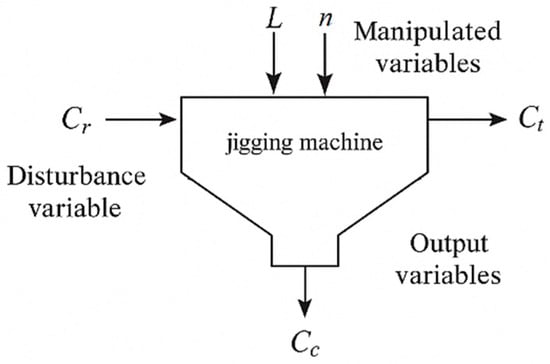
Figure 2.
Manipulated, disturbance, and output variables of a jigging machine.
The pulsation frequency () is one of the key adjustable parameters that determines the intensity of water movement through the bed [22]. At low frequencies, separation remains insufficient, as light particles may remain in the concentrate. Optimum pulsation frequency ensures clear separation: heavy particles settle in the concentrate and light particles pass into the tails. However, too high a frequency leads to destabilization of the bed and mixing of particles, which reduces the quality of the concentrate. The bed thickness () also plays an important role: a bed that is too thin does not allow the formation of effective separation zones, while an excessively thick bed increases the resistance to particle movement and reduces the efficiency of the process.
At the same time, the technological indicators of beneficiation of the jigging machine are simultaneously influenced by about 20 factors determined by the characteristics and feeding mode of the machines, and the technological and hydrodynamic parameters of the process. Many of these factors interact in complex ways and behave unpredictably under varying conditions. Input disturbances are mainly associated with the variable nature of the raw material properties. These are the ore concentration in the enriched material, the sieve, and fractional composition of the feedstock ore [24]. Effective control of these parameters requires a deep understanding of the patterns of particle movement in jigging machines, taking into account the need to develop new approaches that take into account the actual operating conditions of the equipment and the stochastic nature of the feedstock.
The scientific novelty of the work lies in the integration of three different models—a regression model, a mathematical model of particle motion, and a neural network for a more accurate and adaptive description of the chromite ore beneficiation process. Unlike traditional methods, which typically use only one model, this work proposes a comprehensive approach that takes into account both the dynamics of particle motion in the jigging machine and the variability of the raw material composition.
A regression model is used for initial estimation of separation parameters, but its accuracy is limited, as it does not take into account complex physical interactions and variability of feedstock composition. For a more detailed description of particle behavior in a jig, a particle motion model is considered that takes into account gravitational forces, fluid resistance and bed pulsations that affect particle settling and retention of waste rock in suspension. A neural network is used to account for changing parameters of ore composition and adapt the control system to these changes. A hybrid model combining these components provides more accurate forecasts and improves the efficiency of the beneficiation process by adapting to changing conditions and composition of the feedstock ore.
3. Hybrid Modeling Approach
3.1. Regression-Based Estimation Model
To provide a quick estimate of the output parameters, a regression model was initially developed. Empirical data from the gravity concentration process of chromite ore were used to construct a regression model relating bed thickness and pulsation frequency to the percentage of chromium in concentrate and tailings.
Let the mathematical regression model be described by second-order multiple regression Equations [30]:
where and are coefficients determined on the basis of experimental data by the least squares method.
The regression model allows for the rapid and efficient assessment of separation quality based on known control parameters of the settling process. To predict the change in parameters based on the regression model, a surface (see Figure 3) was constructed for and as functions of bed level () and pulsation frequency () based on regression modeling. The red dots show the original data.

Figure 3.
Simulated surface showing the Cr2O3 content in concentrate () and tailings ().
The graph of chromium concentration in concentrate shows the dependence of on two parameters: and . Increasing and shows a nonlinear effect on the value; at low values of and , the chromium content in concentrate is significantly lower . The optimum region providing the maximum chromium content is at average bed thickness values and a higher pulsation frequency . The graph of chromium concentration in tailings reflects the dependence of on the same parameters and , where the chromium content in tailings becomes minimal .
A correlation is observed between the parameters and , which determines the quality of separation: high pulsation frequency and medium bed thickness provide optimal beneficiation, which leads to maximization of the chromium content in the concentrate and minimization of losses in the tailings. At too large values of or , deterioration of separation may occur, since both increases in and decreases in are observed, which is associated with bed instability and redistribution of heavy particles.
Thus, the regression model serves as a practical tool for predicting concentrations, but for a deeper understanding of the separation process and justification of the choice of these parameters, it is necessary to use a particle motion model. The mathematical description of particle motion helps to fine-tune the control system of the jigging machine, increasing the efficiency of the beneficiation process and reducing chromium losses.
3.2. Particle Motion Model Under Pulsation
Although the regression model captures empirical relationships, a physics-based particle motion model is required to understand the underlying separation dynamics. This section introduces a mathematical model that describes the motion of chromite concentrate and waste rock particles within the pulsating gravity field of a jigging machine [22]. The primary objective is to analyze the influence of pulsation frequency on the trajectories of particles with varying densities and sizes.
Due to the fact that modern models of gravity ore purification have a number of assumptions and are associated with the study of particle movement in laboratory conditions [31], it is proposed to develop and study a mathematical model of the movement of concentrate particles and waste rock in the gravity field of a jigging machine. This model will allow determining the influence of pulsation frequency on the trajectories of particles of concentrate and waste rock of chromite ore.
The model is constructed based on Newton’s second law with added hydrodynamic forces [22], allowing the description of particle motion under all relevant physical forces acting on it. The following notations are introduced to analyze the motion: is coordinate of particle movement at a given moment in time t, is particle velocity, is acceleration of a particle. Taking into account all the acting forces, the equation of motion of an individual particle is written as a system:
where is the density of the fluid; is the gravitational acceleration; is the particle volume; is the dynamic viscosity of the fluid; is the particle radius; is the pulsation amplitude; is the angular pulsation frequency; is time.
The presented equations describe the kinematics and dynamics of particle motion in a pulsating gravity field, taking into account the acting forces. The developed model allows us to estimate the influence of the frequency and the amplitude of the pulsation on the trajectories of particles and the efficiency of their separation.
To obtain the results of modeling the equations, we use the initial conditions and parameters (see Table 2).

Table 2.
Initial condition for the algorithm.
The results of the particle motion simulation are presented in Figure 4.
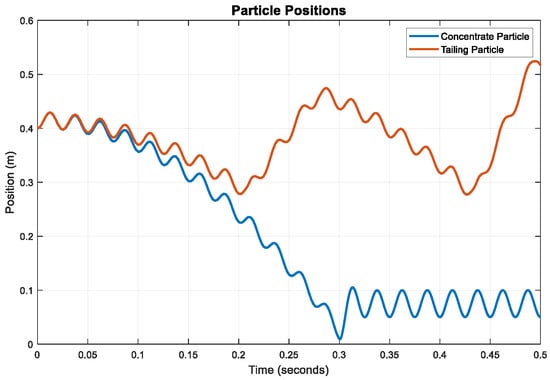
Figure 4.
Simulated trajectories of light and heavy particles in a jigging machine.
A particle motion model predicts the speed with which chromite ore settles in a jigging machine, based on gravity and fluid resistance. Faster settling concentrates more chromium at the bottom of the bed. The process also depends on bed pulsations: Higher amplitude and frequency improve the separation of heavier particles.
As shown in Figure 4, the concentrate particles (blue line) settle faster, while the smaller and lighter waste rock particles (red line) remain suspended longer. Stronger pulsations help maintain this suspension, reducing the chromium content in tailings. The effectiveness of separation is directly related to how well heavy particles settle and how well light particles are retained in suspension.
The model calculates the settling velocity as a function of process parameters such as the level of the bed and the pulsation frequency. On the basis of these results, a regression model can be constructed for the and concentrations. Thus, the particle motion model provides the physical basis for optimizing jig parameters, enhancing prediction accuracy, and beneficiation performance.
3.3. Design and Training of the Neural Network
To describe the separation process more accurately, it is necessary to consider the percentage of chromium in the feedstock ore, , as a disturbing effect. This is because the composition of the feedstock ore, which can vary, has a significant effect on the settling efficiency. The characteristics of chromite ore may vary depending on its chromium content, which affects the behavior of the particles during the settling process.
Models that do not account for this variation may produce inaccurate results because they cannot properly account for the effect of feedstock composition on the beneficiation process. If the chromium content of the feedstock ore is high, the concentrate will have more chromium, but this can also affect particle settling, as particle size and density can vary depending on the composition.
In such cases, it will be necessary to adjust the bed level and pulsation frequency parameters to effectively separate chromium from waste rock. If the chromium content is low, the particles may settle more slowly, and this will also require adjustment of the control system parameters. For example, at low chromium content, the pulsation frequency can be increased to improve the efficiency of holding waste rock in suspension and improve separation.
As part of the task for jigging machine process control, a predictive model based on a neural network was developed [16]. The development of a neural network architecture made it possible to take into account the nonlinear and multiparametric nature of the process, as well as to adapt to the changing composition of the processed raw materials.
The model variables are normalized values obtained empirically during the jigging machine operation. The neural network was also trained on data obtained using a mathematical model of the motion of chromium particles, which ensures that the model corresponds to the physics of the process.
The developed neural network is a classical multilayer perceptron (MLP) architecture (see Figure 5). The circuit architecture consists of the following:
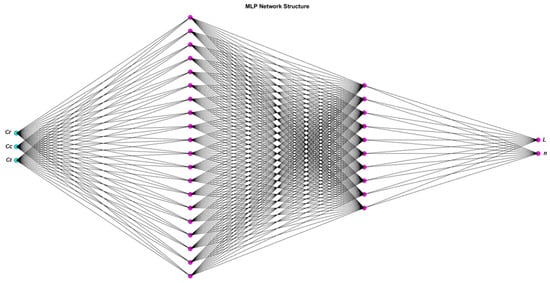
Figure 5.
Structure of the multilayer perceptron.
- First bullet input parameters: (normalized values); output ;
- Two hidden layers: [3 inputs] → [20 neurons] → [10 neurons] → [2 outputs];
- Activation functions: ReLU in hidden layers, linear activation at output;
- Error function: mean squared error (MSE);
- Optimization algorithm: stochastic gradient descent (SGD) with adaptive learning rate.
The accuracy assessment of the neural network model showed high approximation ability (see Figure 6): the mean squared error for predicting the chromium content in tailings was in normalized units, which corresponds to a real error of about of the chromium content in tailings. The mean squared error for predicting the chromium content in concentrate was , providing an accuracy within . The determination coefficient is and , respectively. This indicates a reliable approximation of complex dependencies between process parameters.
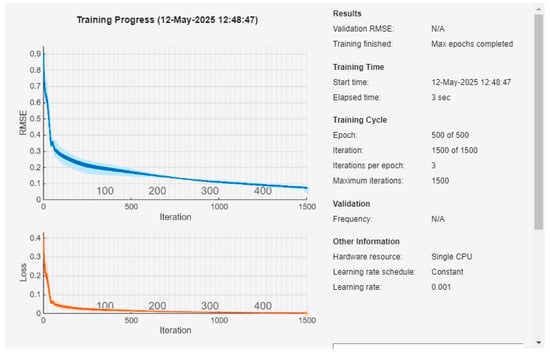
Figure 6.
Training progress of the hybrid neural network model.
The neural network was trained on a dataset consisting of 1500 samples. These samples included both real experimental data collected from the jigging machine and synthetic data generated using the particle motion model described in Section 3.2. The dataset was divided into three subsets: training (70%), validation (15%), and testing (15%). To prevent overfitting, L2 regularization and an early stopping criterion based on validation loss were employed. The learning curves were monitored throughout the training process. No significant overfitting was observed, and the final model performed stably on the test set.
To improve the accuracy and interpretability of the model, the study used a hybridization of approaches: the neural network was supplemented with a second-order polynomial regression, which made it possible to take into account the a priori physical laws of the process and increase the prediction accuracy by 15–20%.
Including as an additional input parameter allows the neural network model to take into account the impact of changes in the feedstock composition on the output characteristics of the process. This enables adaptive control: when changes, the model adjusts the recommended values of and to take into account the new conditions, thereby increasing the separation efficiency and reducing chromium losses in the tailings.
4. Optimization Methodology
4.1. Objective Function and Optimization Method
Based on the outputs of the hybrid model, an optimization strategy was formulated to regulate control parameters. The objective of developing an optimal control system for the beneficiation process of chromite ore is to minimize the chromium content in tailings while simultaneously increasing its extraction into concentrate [30].
The integration of a mathematical model of particle motion, a predictive neural network, and an optimization algorithm ensures high adaptability of the control system. As a result, the proposed approach allows implementing an intelligent system for regulating the jigging process, capable of automatically adapting to changing ore properties and maintaining an optimal beneficiation mode.
This leads to a reduction in chromium losses in tailings and an increase in its content in the concentrate, which significantly increases the overall efficiency of the gravity beneficiation process.
The developed methodology combines numerical modeling of particle motion, a neural network, and an optimization algorithm based on minimization of the objective function using the method in the MATLAB R2024a environment [32]. This numerical method, based on the Interior-Point algorithm, allows us to effectively solve nonlinear optimization problems with constraints, providing a search for solutions that satisfy the conditions of the technological process. The use of barrier functions in the structure of the algorithm allows for keeping control parameters within acceptable limits without violating the physical feasibility of the process.
The objective optimization function is formulated as a combination of extraction efficiency and loss minimization indicators:
where are coefficients determining the priority of chromium extraction and loss minimization. The weighting factors and were chosen based on empirical data and pilot tests. Sensitivity analysis with 0.1 step variations confirmed that this ratio ensures a stable balance between product quality and tailings minimization.
The search for optimal values of and is carried out within acceptable limits, , .
For stable operation of the system, dynamic updating of the value is used using the simple moving average method (SMA):
where is filter window size (user-defined).
This processing allows taking into account trends in ore composition and reduces the impact of random fluctuations.
4.2. Optimization Procedure
The algorithm presents the optimal control parameter selection.
Step 0. Initialization: loading the trained neural network, setting initial conditions and constraints. The pretrained hybrid neural network model is loaded. Control bounds for the optimization parameters (bed level and pulsation frequency ) are defined and normalized. Initial guesses for L and n are also set in normalized form.
Step 1. Real-Time Acquisition and Preprocessing. Read from sensor. The current feed composition is measured from the process sensor. Filter (moving average). To reduce the effect of fluctuations, a moving average filter is applied (5). The filtered value is normalized to the neural network input range.
Step 2: Parameter Normalization. The input variables are normalized into a unit range to match the training conditions of the neural network:
Step 3. Build cost function according to the Formula (4).
Step 4. Numerical Optimization . The objective function is minimized using the fmincon solver (Interior-Point algorithm) in MATLAB R2024a. The neural network is called within the objective function to predict and at each iteration. The optimizer selects the control variables that minimize the cost function .
Step 5. Denormalization. After the optimal normalized values were obtained, they were converted to physical units via
Step 6. Actuation. The optimized control parameters () are transmitted to the process control system for real-time actuation.
Step 7. Adaptive Recalculation. The optimization routine is executed periodically every seconds, allowing the algorithm to adapt to changes in ore composition and maintain control robustness in the face of disturbances.
The graph (see Figure 7) shows the convergence of the objective function during the optimization process.

Figure 7.
Convergence of the optimization algorithm for the objective function .
It is evident that the algorithm rapidly reduces the criterion value in the first 5–7 iterations, after which a gradual approach to the optimum occurs. This indicates good convergence of the method and its stability in searching for the best parameters for controlling the chromium settling process.
4.3. Comparison of Optimization Algorithms
Among the available solvers, the Interior-Point method was selected due to its robustness in constrained nonlinear problems. Figure 8 shows the results of a comparison of three optimization methods (Interior-Point, Genetic Algorithm, and Gradient Descent) in terms of speed and nature of convergence of the objective function .
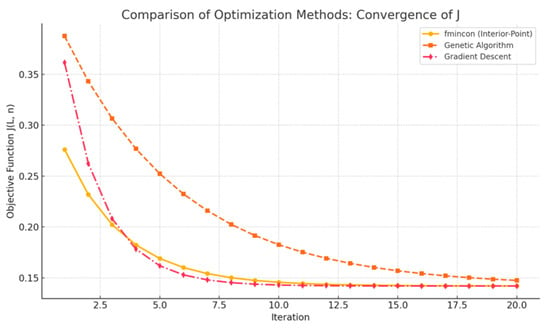
Figure 8.
Comparison of three optimization methods.
While the Genetic Algorithm demonstrated good global search capabilities, it required significantly more iterations to reach convergence and showed less consistent performance across runs. Gradient Descent, although computationally efficient per iteration, was highly sensitive to initial conditions and often converged to local minima. In contrast, the Interior-Point method consistently achieved rapid convergence to near-optimal solutions with fewer iterations and stable performance, even under parameter variability. This balance between convergence speed, accuracy, and robustness under constraints makes it well-suited for real-time optimization in industrial beneficiation processes.
Comparative analysis of three optimization methods—Interior-Point (fmincon), Genetic Algorithm, and Gradient Descent—showed that the fmincon (Interior-Point) method provides the fastest decrease in the value of the objective function , (see Figure 8). Additionally, this method is well adapted to problems with constraints, which makes it optimal for solving the problem of adjusting control parameters in a real technological process.
4.4. Optimization Results and Visualization
Table 3 shows the values and ranges of the variable parameters used in the optimization process.

Table 3.
Initial condition and parameters.
To visualize the optimization results, the surfaces of the objective function , parameters and were constructed depending on the control variables, and (see Figure 9). The graphs also show the optimal points found.
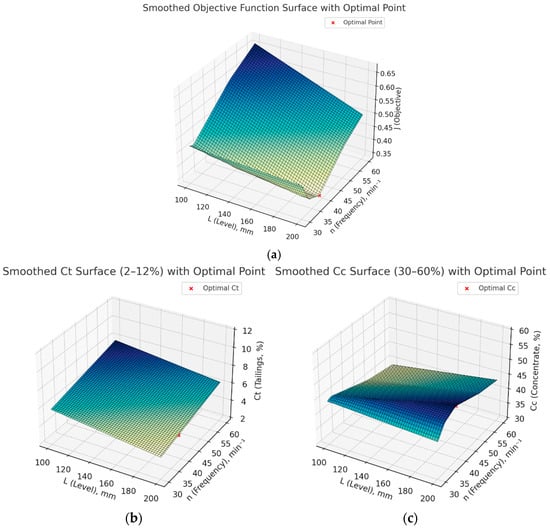
Figure 9.
Surfaces of the objective function and the predicted Cr2O3 values with the optimal points: (a) Surfaces of ; (b) surfaces of ; (c) surfaces of .
The surface shows that at low bed level values and high pulsation frequency values, chromium losses increase, which is due to the deterioration of particle separation conditions. The optimum control point, marked on the graph, corresponds to the combination of parameters at which chromium losses are minimal—this is evident from the lowest value and the highest value in this region. A clearly defined minimum on the surface of the objective function indicates the existence of a region of optimal parameters, which confirms the effectiveness of the selected model and the applied optimization method.
5. Discussion
The developed hybrid control system was tested under simulation conditions and in a digital twin environment. The HMI, developed in the SIMATIC WinCC environment, allows visualization of the control process, analysis, and archiving of the settling process parameters (see Figure 10). This makes the system suitable for industrial integration as part of new-generation digital solutions.
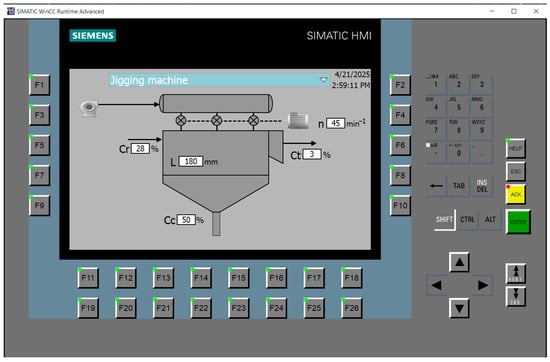
Figure 10.
HMI for monitoring and controlling the chromite ore jigging process.
The screen displays the current values of the process parameters: Cr2O3 content in the feedstock ore , bed level , pulsation frequency , Cr2O3 content in tailings and in the concentrate .
The results of modeling the jigging control process using a digital twin are shown in Figure 11.

Figure 11.
Dependence of chromium content in tailings on bed level (a) and pulsation frequency (b).
The graph shows the dependence of the chromium content in tailings on the bed thickness and the pulsation frequency. With a relatively stable bed thickness (red line), the chromium content in tailings (blue line) remains within the permissible range, not exceeding . This indicates the correct operation of the control system and the efficiency of the optimization algorithm used. With minor fluctuations in the pulsation frequency in the range of (red line), stabilization of the chromium content in the tailings at a level of (blue line) is observed, which indicates the effective operation of the control algorithm and the ability of the system to maintain the specified beneficiation mode.
The use of an optimization algorithm has made it possible to significantly reduce chromium losses. When switching from random selection of parameters to optimized values, the level of chromium content in tailings decreases, for example, from 7.5% to 5.5%. This corresponds to a retention of up to 2% chromium, which is a critical indicator when processing large volumes of ore.
The final model achieved an MSE of less than 0.01 on the test set. To verify the stability of the model, repeated training was performed with different random seeds and cross-validation splits. The standard deviation of the MSE remained below 0.002, and the 95% confidence interval for the predicted Cr2O3 values remained within ± 0.3%. The observed performance improvements, such as reduction of chromium in tailings losses from 7.5% to 5.5%, were stable across multiple runs. Operational data analysis indicates that suboptimal control may lead to losses equivalent to 2–2.5 t of saleable concentrate with 53% grade per shift. These findings highlight that the proposed system is not only technically feasible but also economically attractive for industrial deployment.
The conducted numerical experiments confirm that the hybrid model, which combines physical and intellectual components, is highly adaptable and can be successfully used to control complex, dynamically changing processes. The advantage of the approach is not only the accuracy of forecasting but also the interpretability of the model based on physical laws. The proposed hybrid control system is not limited to the application of chromite ore beneficiation. It can also be applied to other mineral separation processes, provided that the relevant process parameters are accurately modeled and sufficient training data are available for the system to learn from. This flexibility increases the potential for the wider implementation of sustainable technologies in the mineral processing industry.
Despite the positive results obtained, it should be noted that the efficiency of the algorithm may decrease in the presence of significant noise in the data or with sharp jumps in ore parameters. Further research can be aimed at introducing more robust optimization methods and expanding the model architecture with additional sensors and parameters.
While the current hybrid system combines physical modeling, regression, and neural networks to provide accurate and interpretable control, its real-time adaptability can be enhanced through advanced AI techniques. Reinforcement learning [33] enables autonomous tuning under delayed feedback, while federated learning [34] supports distributed model training without data exchange. Transfer learning [35] facilitates faster adaptation to new ore types and conditions, and explainable AI [36] improves interpretability and trust in predictions. These methods can complement the hybrid system and offer promising directions for future applications in sustainable mineral processing.
6. Conclusions
This study presents the development and implementation of a hybrid intelligent control system for chromite ore beneficiation using a jigging machine, aiming to enhance process efficiency and promote sustainable mineral processing. The proposed methodology integrates a physical model of particle motion, a predictive neural network, and a numerical optimization algorithm to adaptively control the jigging process under varying ore compositions.
The system demonstrated high efficiency in predicting chromium concentrations in both concentrate and beneficiation tailings with low mean squared error .
A structured sustainability impact analysis confirms the contribution of the system to key pillars of sustainable development.
- (1)
- Environmental impact: The reduction in the chromium content in the tailings from approximately 7.5% to 5.5% decreases heavy metal discharge and mitigates ecological risks.
- (2)
- Economic effect: An improvement in concentrate quality by 3–6% is achieved without additional operational costs, increasing product value, and overall process profitability.
- (3)
- Resource efficiency: Enhanced separation performance reduces the need for reprocessing, indirectly minimizing material and energy consumption.
These results confirm the effectiveness of the hybrid approach in optimizing separation performance, especially with varying feedstock compositions. In addition, the integration of the model into the HMI environment via SIMATIC WinCC enables practical implementation and operator interaction, enhancing the industrial feasibility of the system.
In summary, the hybrid intelligent system presented in this work offers a promising solution for real-time sustainable control of gravity separation processes. Future research will focus on extending the approach to other ore types and integrating additional optimization methods to further improve robustness and adaptability.
Author Contributions
Conceptualization, O.S., B.S. and Y.K.; methodology, O.S. and B.S.; software, O.S.; validation, O.S., B.S. and Y.K.; formal analysis, O.S. and Y.K.; investigation, O.S., B.S. and Y.K.; resources, B.S. and Y.K.; data curation, O.S. and Y.K.; writing—original draft preparation, O.S.; writing—review and editing, B.S. and Y.K.; visualization, O.S. and Y.K.; supervision, B.S.; project administration, B.S.; funding acquisition, B.S. All authors have read and agreed to the published version of the manuscript.
Funding
This research was funded by the Science Committee of the Ministry of Science and Higher Education of the Republic of Kazakhstan, grant number AP19674691.
Institutional Review Board Statement
Not applicable.
Informed Consent Statement
Not applicable.
Data Availability Statement
Data are contained within the article.
Conflicts of Interest
The authors declare no conflicts of interest.
References
- Franks, D.M.; Boger, D.V.; Côte, C.M.; Mulligan, D.R. Sustainable development principles for the disposal of mining and mineral processing wastes. Resour. Policy 2011, 36, 114–122. [Google Scholar] [CrossRef]
- Sun, Z.; Fan, X. Environment and Health Implications of Mine and Metallurgy Waste-Based AAMs. In Mining and Metallurgical Wastes Based Alkali-Activated Materials; Springer: Singapore, 2024; pp. 215–231. [Google Scholar] [CrossRef]
- Zhdanov, A.V.; Zhuchkov, V.I.; Dashevskii, V.Y.; Leont’Ev, L.I. Problems with Waste Generation and Recycling in the Ferroalloys Industry. Metallurgist 2015, 58, 1064–1070. [Google Scholar] [CrossRef]
- Chanturia, V.A.; Nikolaev, A.I.; Aleksandrova, T.N. Innovative Environmentally Safe Processes for the Extraction of Rare and Rare-Earth Elements from Complex Ores of Perplexed Material Composition. Geol. Ore Depos. 2023, 65, 425–437. [Google Scholar] [CrossRef]
- Lottermoser, B. Recycling, Reuse and Rehabilitation of Mine Wastes. Elements 2011, 7, 405–410. [Google Scholar] [CrossRef]
- Iluţiu-Varvara, D.-A.; Aciu, C. Metallurgical Wastes as Resources for Sustainability of the Steel Industry. Sustainability 2022, 14, 5488. [Google Scholar] [CrossRef]
- Nwaila, G.T.; Frimmel, H.E.; Zhang, S.E.; Bourdeau, J.E.; Tolmay, L.C.K.; Durrheim, R.J.; Ghorbani, Y. The minerals industry in the era of digital transition: An energy-efficient and environmentally conscious approach. Resour. Policy 2022, 78, 102851. [Google Scholar] [CrossRef]
- Jayawardane, H.; Davies, I.J.; Gamage, J.R.; John, M.; Biswas, W.K. Sustainability perspectives—A review of additive and subtractive manufacturing. Sustain. Manuf. Serv. Econ. 2023, 2, 100015. [Google Scholar] [CrossRef]
- Duarte, J.; Baptista, J.S. Digital Twin Applications in the Extractive Industry—A Short Review. In Occupational and Environmental Safety and Health V; Arezes, P.M., Baptista, J.S., Barroso, M.P., Carneiro, P., Cordeiro, P., Costa, N., Melo, R.B., Miguel, A.S., Perestrelo, G., Eds.; Studies in Systems, Decision and Control; Springer: Cham, Switzerland, 2024; Volume 492. [Google Scholar] [CrossRef]
- Nobahar, P.; Xu, C.; Dowd, P.; Shirani Faradonbeh, R. Exploring digital twin systems in mining operations: A review. Green Smart Min. Eng. 2024, 1, 474–492. [Google Scholar] [CrossRef]
- Hasidi, O.; Abdelwahed, E.H.; Alaoui-Chrifi, M.; Qazdar, A.; Benzakour, I.; Bourzeix, F.; Bendaouia, A. Digital twin of minerals processing operations for an advanced monitoring and supervision: Froth flotation process case study. Int. J. Adv. Manuf. Technol. 2024, 132, 1031–1049. [Google Scholar] [CrossRef]
- Hazrathosseini, A.; Afrapoli, A.M. The advent of digital twins in surface mining: Its time has finally arrived. Resour. Policy 2023, 80, 103155. [Google Scholar] [CrossRef]
- Fan, Z.; Yan, Z.; Wen, S. Deep Learning and Artificial Intelligence in Sustainability: A Review of SDGs, Renewable Energy, and Environmental Health. Sustainability 2023, 15, 13493. [Google Scholar] [CrossRef]
- Mutanov, G.; Omirbekova, Z.; Shaikh, A.A.; Issayeva, Z. Sustainability-Driven Green Innovation: Revolutionising Aerospace Decision-Making with an Intelligent Decision Support System. Sustainability 2024, 16, 41. [Google Scholar] [CrossRef]
- Muntin, A.V.; Zhikharev, P.Y.; Ziniagin, A.G.; Brayko, D.A. Artificial Intelligence and Machine Learning in Metallurgy. Part 1. Methods and Algorithms. Metallurgist 2023, 67, 886–894. [Google Scholar] [CrossRef]
- Zulu, N.; Mvita, M.; Thethwayo, B.M. A Systematic Review on Applications of Artificial Neural Networks in the Extraction Metallurgy Industry. In Proceedings of the 6th European Conference on Industrial Engineering and Operations Management, Lisbon, Portugal, 18–20 July 2023; pp. 1519–1531. [Google Scholar] [CrossRef]
- Liu, Y.; Wang, X.; Zhang, Z.; Deng, F. A review of deep learning in image classification for mineral exploration. Miner. Eng. 2023, 204, 108433. [Google Scholar] [CrossRef]
- Estay, H.; Lois-Morales, P.; Montes-Atenas, G.; Ruiz del Solar, J. On the Challenges of Applying Machine Learning in Mineral Processing and Extractive Metallurgy. Minerals 2023, 13, 788. [Google Scholar] [CrossRef]
- Gomez-Flores, I.; Ilyas, S.; Heyes, G.W.; Kim, H. A critical review of artificial intelligence in mineral concentration. Miner. Eng. 2022, 189, 107884. [Google Scholar] [CrossRef]
- Hodouin, D. Methods for automatic control, observation, and optimization in mineral processing plants. J. Process Control 2011, 21, 211–225. [Google Scholar] [CrossRef]
- Chu, K.; Chen, J.; Yu, A. Applicability of a Coarse-Grained CFD–DEM Model on Dense Medium Cyclone. Miner. Eng. 2016, 90, 43–54. [Google Scholar] [CrossRef]
- Viduka, S.; Feng, Y.; Hapgood, K.; Schwarz, P. CFD-DEM Investigation of Particle Separations Using a Sinusoidal Jigging Profile. Adv. Powder Technol. 2012, 24, 328–342. [Google Scholar] [CrossRef]
- Dong, K.; Kuang, S.; Vince, A.; Hughes, T.; Yu, A. Numerical simulation of the in-line pressure jig unit in coal preparation. Miner. Eng. 2010, 23, 301–312. [Google Scholar] [CrossRef]
- Aras, A.; Taner, H.A. Investigation of Chromite Ore Beneficiation Possibilities with Different Gravity Concentrators. Rud.-Geol.-Naft. Zb. 2023, 38, 127–134. [Google Scholar] [CrossRef]
- Can, İ.B.; Özsoy, B.; Ergün, Ş.L. Developing an optimum beneficiation route for a low-grade chromite ore. Physicochem. Probl. Miner. Process. 2019, 55, 865–878. [Google Scholar] [CrossRef]
- Lim, B.; Alorro, R.D. Technospheric Mining of Mine Wastes: A Review of Applications and Challenges. Sustain. Chem. 2021, 2, 686–706. [Google Scholar] [CrossRef]
- Araujo, F.S.M.; Taborda-Llano, I.; Nunes, E.B.; Santos, R.M. Recycling and Reuse of Mine Tailings: A Review of Advancements and Their Implications. Geosciences 2022, 12, 319. [Google Scholar] [CrossRef]
- Chaurasia, R.C.; Panwar, D.S.; Ken, B.S.; Mehta, J.; Oza, A.D.; Kumar, S.; Kumar, R.; Desai, V.A. Enhancing gravity separation for improved mineral processing. Multidiscip. Sci. J. 2024, 7, 2025190. [Google Scholar] [CrossRef]
- Jiao, S.; Li, W.; Li, Z.; Gai, J.; Zou, L.; Su, Y. Hybrid physics-machine learning models for predicting rate of penetration in the Halahatang oil field, Tarim Basin. Sci. Rep. 2024, 14, 5957. [Google Scholar] [CrossRef]
- Tripathy, S.K.; Murthy, Y.R. Multiobjective optimisation of spiral concentrator for separation of ultrafine chromite. Int. J. Min. Miner. Eng. 2012, 4, 151–162. [Google Scholar] [CrossRef]
- Viduka, S.M.; Feng, Y.Q.; Hapgood, K.; Schwarz, M.P. Discrete particle simulation of solid separation in a jigging device. Int. J. Miner. Process. 2013, 123, 108–119. [Google Scholar] [CrossRef]
- Kaseba, C.; Nheta, W. Application of Response Surface Methodology on the Optimization of Chromite Recovery from the South African Middle Group Chromite Seams. J. Sustain. Metall. 2024, 10, 929–949. [Google Scholar] [CrossRef]
- Gao, Q.; Schweidtmann, A. Deep Reinforcement Learning for Process Design: Review and Perspective. Curr. Opin. Chem. Eng. 2024, 44, 101012. [Google Scholar] [CrossRef]
- Mehta, M.; Bimrose, M.V.; McGregor, D.J.; King, W.P.; Shao, C. Federated Learning Enables Privacy-Preserving and Data-Efficient Dimension Prediction and Part Qualification across Additive Manufacturing Factories. J. Manuf. Syst. 2024, 74, 752–761. [Google Scholar] [CrossRef]
- Boiger, R.; Churakov, S.V.; Ballester Llagaria, I. Direct Mineral Content Prediction from Drill Core Images via Transfer Learning. Swiss J. Geosci. 2024, 117, 8. [Google Scholar] [CrossRef]
- Zuo, R.; Cheng, Q.; Xu, Y. Explainable Artificial Intelligence Models for Mineral Prospectivity Mapping. Sci. China Earth Sci. 2024, 67, 2864–2875. [Google Scholar] [CrossRef]
Disclaimer/Publisher’s Note: The statements, opinions and data contained in all publications are solely those of the individual author(s) and contributor(s) and not of MDPI and/or the editor(s). MDPI and/or the editor(s) disclaim responsibility for any injury to people or property resulting from any ideas, methods, instructions or products referred to in the content. |
© 2025 by the authors. Licensee MDPI, Basel, Switzerland. This article is an open access article distributed under the terms and conditions of the Creative Commons Attribution (CC BY) license (https://creativecommons.org/licenses/by/4.0/).